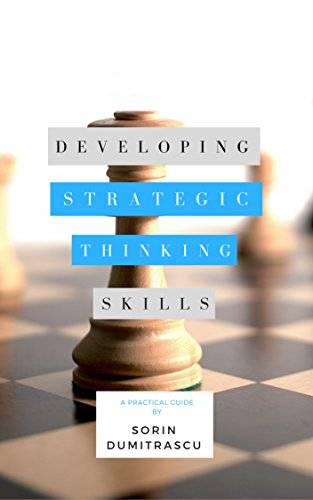

Developing Strategic Thinking Skills: A Practical Guide
by Sorin Dumitrascu
Strategy refers to the direction an organization or business unit takes to achieve its vision, mission, and goals. Organizational strategies include strategies at the corporate, business, and functional levels.
Strategic thinking is essential at all levels, including functional levels. It equips functional managers and departmental leaders to make long-term decisions that align with their organizations' corporate and business strategies, encourages new ways of thinking, and overcomes the constraints associated with having limited information. In effect, it contributes to their success.
Strategic thinking has five main characteristics. It's focused on an organization's strategic vision, involves adopting a systems view, takes a long-term approach, involves being ready to take advantage of opportunities, and considers the past and present.
Traits of strategic thinkers typically include flexibility, openness, a positive outlook, curiosity, future focus, and an ability to identify connections and patterns. Common barriers to thinking strategically include unchallenged assumptions, knowledge that's no longer relevant, reliance on what worked in the past, rigidity, linearity, closed-mindedness, and framing.
Anyone can develop the ability to think strategically and to do this you can carry out certain steps. Develop a clear vision by speaking to senior management and peers, collaborating with individuals, setting priorities, and making trade-offs.
To think strategically, you also have to think creatively. You can learn to do this by regularly challenging assumptions, visualizing possibilities, and participating in creative endeavors.
You also have to be prepared to deal with complexity. You need to adopt a big picture view of your organization, be able to recognize trends and patterns, and align your ideas with strategic objectives. You need to become aware of what's going on across your organization and in its broader environment.
To think strategically and see the bigger picture, it's important to understand both the external and internal contexts of your organization. You can use Porter's model of five forces to help you understand and assess your organization's external environment.
To understand the internal context in which you operate, you need to understand your organization's strategic goals and direction, and how your department can align with these. You should also identify potential stakeholders, gather their input on potential actions, and ensure you consider the impact of your decisions on them.
A big-picture perspective enables you to create a mental model of the complete system of value creation within your organization. You can understand the value chain in terms of Porter's primary and support activities.
Strategic thinking is essential at all levels, including functional levels. It equips functional managers and departmental leaders to make long-term decisions that align with their organizations' corporate and business strategies, encourages new ways of thinking, and overcomes the constraints associated with having limited information. In effect, it contributes to their success.
Strategic thinking has five main characteristics. It's focused on an organization's strategic vision, involves adopting a systems view, takes a long-term approach, involves being ready to take advantage of opportunities, and considers the past and present.
Traits of strategic thinkers typically include flexibility, openness, a positive outlook, curiosity, future focus, and an ability to identify connections and patterns. Common barriers to thinking strategically include unchallenged assumptions, knowledge that's no longer relevant, reliance on what worked in the past, rigidity, linearity, closed-mindedness, and framing.
Anyone can develop the ability to think strategically and to do this you can carry out certain steps. Develop a clear vision by speaking to senior management and peers, collaborating with individuals, setting priorities, and making trade-offs.
To think strategically, you also have to think creatively. You can learn to do this by regularly challenging assumptions, visualizing possibilities, and participating in creative endeavors.
You also have to be prepared to deal with complexity. You need to adopt a big picture view of your organization, be able to recognize trends and patterns, and align your ideas with strategic objectives. You need to become aware of what's going on across your organization and in its broader environment.
To think strategically and see the bigger picture, it's important to understand both the external and internal contexts of your organization. You can use Porter's model of five forces to help you understand and assess your organization's external environment.
To understand the internal context in which you operate, you need to understand your organization's strategic goals and direction, and how your department can align with these. You should also identify potential stakeholders, gather their input on potential actions, and ensure you consider the impact of your decisions on them.
A big-picture perspective enables you to create a mental model of the complete system of value creation within your organization. You can understand the value chain in terms of Porter's primary and support activities.

